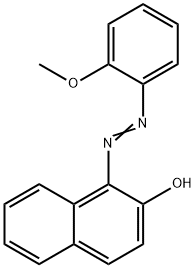Chemical Properties
Solvent Red 1, also known as Sudan Red G, is a yellowish red lysochrome azo dye. It has the appearance of an odorless reddish-orange powder with melting point 225 °C. It is soluble in fats and used for coloring of fats, oils, and waxes, including the waxes used in turpentine-based polishes. It is also used in polystyrene, cellulose, and synthetic lacquers. It is insoluble in water. It is stable to temperatures of about 100–110 °C. It was formerly used as a food dye, but still appears to be used for this purpose in china. It is used in some temporary tattoos, where it can cause contact dermatitis. It is also used in hair dyes. It is a component of some newer formulas for red smoke signals and smoke-screens, together with Disperse Red 11.
Uses
Sudan dyes and para red in food. Dyes and metabolites, Environmental Testing.
Preparation
O-Anisidine diazotization, and Naphthalen-2-ol coupling.
General Description
Sudan dyes are classified under the azo dyes group of organic compounds that are commonly utilized as additive materials for industrial and scientific applications.
Safety Profile
An eye irritant. When
heated to decomposition it emits toxic
fumes of NOx.
Properties and Applications
red to yellow red orange. Appearance is red to yellow red orange powder, the products by glacial acetic acid crystallization melting point 180 ℃. Soluble in boiling ethanol to red. Light fastness is poorer, in 110 ℃ when stability. In concentrated sulfuric acid for deep red, dilution after dark red precipitation. The alcohol solution to join hydrochloric acid for wine red; Add sodium hydroxide as orange. Mainly used in oil, wax and cultural and educational supplies coloring.
|
Standard
|
Light Fastness
|
Heat-resistant(℃)
|
water
|
Sodium Carbonate(5%)
|
Hydrochloric acid(5%)
|
|
Melting point
|
Stable
|
|
ISO
|
Poor-General
|
170-180
|
100-110
|
Insoluble
|
No change
|
No change
|


